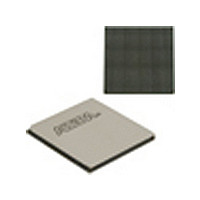EP4SGX530HH35C2N Altera, EP4SGX530HH35C2N Datasheet - Page 360

EP4SGX530HH35C2N
Manufacturer Part Number
EP4SGX530HH35C2N
Description
IC STRATIX IV FPGA 530K 1152HBGA
Manufacturer
Altera
Series
Stratix® IV GXr
Datasheets
1.EP4SGX110DF29C3N.pdf
(80 pages)
2.EP4SGX110DF29C3N.pdf
(1154 pages)
3.EP4SGX110DF29C3N.pdf
(432 pages)
4.EP4SGX110DF29C3N.pdf
(22 pages)
5.EP4SGX110DF29C3N.pdf
(30 pages)
6.EP4SGX110DF29C3N.pdf
(72 pages)
7.EP4SGX530HH35C2N.pdf
(1145 pages)
Specifications of EP4SGX530HH35C2N
Number Of Logic Elements/cells
531200
Number Of Labs/clbs
21248
Total Ram Bits
27376
Number Of I /o
564
Voltage - Supply
0.87 V ~ 0.93 V
Mounting Type
Surface Mount
Operating Temperature
0°C ~ 85°C
Package / Case
1152-HBGA
Family Name
Stratix® IV
Number Of Logic Blocks/elements
531200
# Registers
424960
# I/os (max)
560
Process Technology
40nm
Operating Supply Voltage (typ)
900mV
Logic Cells
531200
Ram Bits
28033024
Operating Supply Voltage (min)
0.87V
Operating Supply Voltage (max)
0.93V
Operating Temp Range
0C to 85C
Operating Temperature Classification
Commercial
Mounting
Surface Mount
Pin Count
1152
Package Type
FCHBGA
Lead Free Status / RoHS Status
Lead free / RoHS Compliant
Number Of Gates
-
Lead Free Status / Rohs Status
Compliant
Available stocks
Company
Part Number
Manufacturer
Quantity
Price
- EP4SGX110DF29C3N PDF datasheet
- EP4SGX110DF29C3N PDF datasheet #2
- EP4SGX110DF29C3N PDF datasheet #3
- EP4SGX110DF29C3N PDF datasheet #4
- EP4SGX110DF29C3N PDF datasheet #5
- EP4SGX110DF29C3N PDF datasheet #6
- EP4SGX530HH35C2N PDF datasheet #7
- Current page: 360 of 1154
- Download datasheet (32Mb)
10–26
Stratix IV Device Handbook Volume 1
PS Configuration Using a MAX II Device as an External Host
1
In this configuration scheme, you can use a MAX II device as an intelligent host that
controls the transfer of configuration data from a storage device, such as flash
memory, to the target Stratix IV device. You can store configuration data in .rbf, .hex,
or .ttf format.
Figure 10–10
device and a MAX II device for single device configuration.
Figure 10–10. Single Device PS Configuration Using an External Host
Note to
(1) Connect the resistor to a supply that provides an acceptable input signal for the Stratix IV device. V
After power-up, Stratix IV devices go through a POR. The POR delay depends on the
PORSEL pin setting. When PORSEL is driven low, the standard POR time is
100 ms < T
4 ms < T
all user I/O pins. After the device successfully exits POR, all user I/O pins continue to
be tri-stated. If nIO_pullup is driven low during power-up and configuration, the user
I/O pins and dual-purpose I/O pins will have weak pull-up resistors that are on
(after POR) before and during configuration. If nIO_pullup is driven high, the weak
pull-up resistors are disabled.
The configuration cycle consists of three stages—reset, configuration, and
initialization. While nCONFIG or nSTATUS are low, the device is in reset. To initiate
configuration, the MAX II device must generate a low-to-high transition on the
nCONFIG pin.
V
be fully powered to the appropriate voltage levels to begin the configuration process.
CC
high enough to meet the V
up all configuration system I/Os with V
, V
Figure
CCIO
POR
(MAX II Device or
, V
Microprocessor)
POR
10–10:
External Host
< 12 ms. During POR, the device resets, holds nSTATUS low, and tri-states
ADDR
shows the configuration interface connections between a Stratix IV
CCPGM
< 300 ms. When PORSEL is driven high, the fast POR time is
Chapter 10: Configuration, Design Security, and Remote System Upgrades in Stratix IV Devices
Memory
, and V
DATA0
IH
specification of the I/O on the device and the external host. Altera recommends powering
CCPD
CCPGM
of the banks where the configuration pins reside must
V
10 k Ω
CCPGM (1)
.
10 k Ω
V
CCPGM (1)
GND
CONF_DONE
nSTATUS
nCE
DATA0
nCONFIG
DCLK
Stratix IV Device
MSEL2
MSEL1
MSEL0
nCEO
April 2011 Altera Corporation
Passive Serial Configuration
N.C.
GND
V
CCPGM
CCPGM
must be
Related parts for EP4SGX530HH35C2N
Image
Part Number
Description
Manufacturer
Datasheet
Request
R

Part Number:
Description:
CYCLONE II STARTER KIT EP2C20N
Manufacturer:
Altera
Datasheet:

Part Number:
Description:
CPLD, EP610 Family, ECMOS Process, 300 Gates, 16 Macro Cells, 16 Reg., 16 User I/Os, 5V Supply, 35 Speed Grade, 24DIP
Manufacturer:
Altera Corporation
Datasheet:

Part Number:
Description:
CPLD, EP610 Family, ECMOS Process, 300 Gates, 16 Macro Cells, 16 Reg., 16 User I/Os, 5V Supply, 15 Speed Grade, 24DIP
Manufacturer:
Altera Corporation
Datasheet:

Part Number:
Description:
Manufacturer:
Altera Corporation
Datasheet:

Part Number:
Description:
CPLD, EP610 Family, ECMOS Process, 300 Gates, 16 Macro Cells, 16 Reg., 16 User I/Os, 5V Supply, 30 Speed Grade, 24DIP
Manufacturer:
Altera Corporation
Datasheet:

Part Number:
Description:
High-performance, low-power erasable programmable logic devices with 8 macrocells, 10ns
Manufacturer:
Altera Corporation
Datasheet:

Part Number:
Description:
High-performance, low-power erasable programmable logic devices with 8 macrocells, 7ns
Manufacturer:
Altera Corporation
Datasheet:

Part Number:
Description:
Classic EPLD
Manufacturer:
Altera Corporation
Datasheet:

Part Number:
Description:
High-performance, low-power erasable programmable logic devices with 8 macrocells, 10ns
Manufacturer:
Altera Corporation
Datasheet:

Part Number:
Description:
Manufacturer:
Altera Corporation
Datasheet:

Part Number:
Description:
Manufacturer:
Altera Corporation
Datasheet:

Part Number:
Description:
Manufacturer:
Altera Corporation
Datasheet:

Part Number:
Description:
CPLD, EP610 Family, ECMOS Process, 300 Gates, 16 Macro Cells, 16 Reg., 16 User I/Os, 5V Supply, 25 Speed Grade, 24DIP
Manufacturer:
Altera Corporation
Datasheet:












